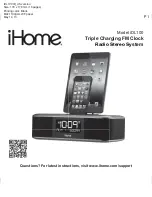
DIGITAL YACHT LTD
CLB2000 Quick Start Guide
The combo antenna has a built-in LNA and an external filter/splitter which needs to be
mounted close to the CLB2000. There are three cables supplied with the filter/splitter;
1)
TNC to FME for GPS
2)
BNC to FME for VHF
3)
PL259 to FME for Combo Antenna
The filter/splitter and two of the three supplied cables are shown in Figure 2. The only
cable not supplied is the cable from the antenna to the filter/splitter.
It is necessary to construct or source this cable which needs to have a Male N-Type
connector at the antenna end and an SO239 connector at the splitter end. You must
use suitable coax cable and Digital Yacht recommend RG214 or an equivalent coax
cable is used.
These three cables should not be extended and it is important that the FME connections
to the filter/splitter are checked to ensure they are correctly tightened. However, be
careful not to over tighten these connections.
Installation of the GPS antenna is critical for the performance of the built in GPS receiver which is used for timing of the
transmitted time slots and for the supply of navigational information should the main navigational GPS fail. We strongly
recommend that t
he GPS antenna is mounted in an elevated position and free of shadow effect from the ship’s
superstructure. If in doubt, make a temporary installation and use the aisPRO software to view the satellite signal
strengths.
The combo VHF/GPS antenna should be mounted with at least a two metre vertical separation distance from any other
VHF antenna used for speech or DCS communication but see also the secti
on “Radio Frequency Exposure Warning”
below.
Installation Step 2
– Mechanical Fixings
Access to the fixing holes is achieved by removal of the two green decal strips down each side of the CLB2000.
Once fixed in place, the green decal strips can be clicked back in place.
Secure the AIS Transponder to a flat surface in the selected location. Use four M4 wood screws or other fixings
suited to the material the unit is being fixed to. The unit may be installed in any orientation
Fixing location drawing
Figure 2

























